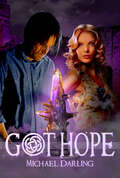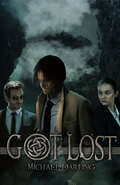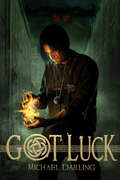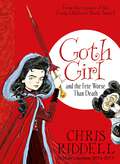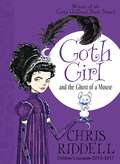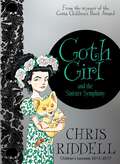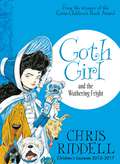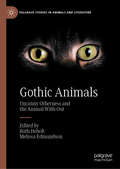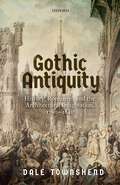- Table View
- List View
Gossip, Letters, Phones: The Scandal of Female Networks in Film and Literature
by Ned SchantzAlthough female communication networks abound in many contexts and have received a good measure of critical scrutiny, no study has addressed their unique significance within narrative culture writ large. Filling this conspicuous gap, Ned Schantz presents a lively exploration of the phenomenon, resituating novelistic culture as central even as he ranges across media and the myriad technologies that attend them. Charting the emergence of female networks via the most prominent modes of communication--gossip, letters, and phones--Schantz brings his study to life with unconventional interpretations of classic British novels and popular Hollywood films spanning multiple genres and time periods. With incisive readings of Clarissa, Emma, and Evelina, Schantz shows how gossip both draws sympathy and is repressed by dominant male culture in a recurrent pattern of avowal and disavowal. The epistolary novel added a rhythm to communication that was generative of fantasy, which in turn informed "telephonic film," a development depicted in analyses of movies such as Sorry, Wrong Number; Vertigo; Terminator; and You've Got Mail. Schantz highlights the way the telephone works as a structuring device, not merely a prop, one that shapes the plot and suggests provocative formal implications. While this study traverses an uncanny realm of lost messages and false suitors, telepathy and artificial intelligence, locked rooms and time-traveling stalkers, these occult concerns only confirm the importance of female communication at its most basic level. Illuminating and accessible--Gossip, Letters, Phones reveals female networks as one of narrative's most supple and persistent elements in literature and cinema.
Gösta Berling's Saga
by Selma LagerlöfThe first woman to receive the Nobel Prize for literature, Selma Lagerlöf assured her place in Swedish letters with this 1891novel. Inspsired by the legends, superstitions, and fairy tales of Lagerlöf's native Värmland region, Gösta Berling's Saga features a vivid cast of characters. The eponymous hero, a country pastor whose appetite for alcohol and indiscretions ends his ministerial career, falls in with a dozen vagrant Swedish cavaliers and enters into a power struggle with the richest woman in the province. Steeped in supernatural lore, the novel's colorful vignettes and striking symbolism continue to enchant readers around the world.Translated by Lillie Tudeer.
Got Hope
by Michael DarlingIn the action-packed sequel to Michael Darling&’s bestselling novel, Got Luck, readers&’ favorite private detective is ready to go back to solving nice, non-magical crimes. But the realm of the Fae has different plans for Got. From the shadows, a secret society moves to dethrone Got&’s father. Despite his best efforts to stay out of Fae politics, Got has become the key to their civil war.
Got Lost
by Michael DarlingMagic and mystery—private detective Got is now well-versed in both. Readers will be on the edge of their seats as their favorite wisecracking private detective dives back into realms of magic in this third installation of the bestselling Tales from the Behindbeyond series.
Got Luck
by Michael DarlingIn this repeated #1 best seller, readers will explore a hidden fantasy realm alongside a wisecracking and tough-as-nails private detective through each and every twist his unusual and otherworldly case throws at them.
Got You Back: A Husband. A Wife. A Mistress. And The Ultimate Plan
by Jane FallonThe brilliantly witty novel from the Top Ten Sunday Times bestselling author of Getting Rid of Matthew.A husband. A wife. A mistress. And the ultimate plan for revenge . . .The husbandJames never intended to lead a double life - with a wife in London and a mistress in the country, it's exhausting. But that's all about to change . . .The wifeStephanie isn't really snooping when she finds a text message from a strange woman on her husband's mobile. But now she's found it, how can she ignore it? It's time to track the woman down and find out what's going on . . . The mistressKatie has no reason to believe her boyfriend, James, is cheating until someone claiming to be his wife gets in touch. Now she's been cast in the role of mistress. Not one she's happy with . . . Once Stephanie and Katie know about each other, they must decide what to do. They could both just throw him out or they could join forces to make his life hell first . . .But revenge isn't always sweet. And what happens when one woman thinks enough is enough but the other doesn't know when to stop?Praise for Jane Fallon:'Intelligent, edgy and witty' Glamour'A brilliant and original tale' Sun'Chick lit with an edge' Guardian
Goth Girl and the Fete Worse Than Death (Goth Girl #2)
by Chris RiddellPacked full of beautiful black-and-white illustrations from author Chris Riddell, Goth Girl and the Fete Worse Than Death is the second in this ghostly, funny series from the Costa Award winner Chris Riddell.Preparations for the Ghastly-Gorm Garden Party and bake-off are under way. Celebrity cooks are arriving at the hall for the big event and, true to form, Maltravers, the indoor gamekeeper, is acting suspiciously. Very suspiciously . . .Elsewhere at Ghastly-Gorm, Ada's wardrobe-dwelling lady's maid Marylebone has received a marriage proposal. Ada vows to aid the course of true love – and find out what Maltravers is up to – but amidst all this activity, everyone, including her father, appears to have forgotten her birthday!Though they can be enjoyed in any order, continue this deliciously dark series with Goth Girl and the Wuthering Fright and Goth Girl and the Sinister Symphony.
Goth Girl and the Ghost of a Mouse (Goth Girl #1)
by Chris RiddellFull of adventure and humour, Goth Girl and the Ghost of a Mouse is the beautifully illustrated winner of the Costa Award – presented here in a gorgeous hardcover. From Chris Riddell, author of the Ottoline series, it is perfect for fans of Howl's Moving Castle and Netflix's Wednesday. Ada Goth is the only child of Lord Goth. The two live together in the enormous Ghastly-Gorm Hall. Lord Goth believes that children should be heard and not seen, so Ada has to wear large clumpy boots so that he can always hear her coming. This makes it hard for her to make friends and, if she's honest, she's rather lonely.Then one day William and Emily Cabbage come to stay at the house, and together with a ghostly mouse called Ishmael they and Ada begin to unravel a dastardly plot that Maltravers, the mysterious indoor gamekeeper, is hatching. Ada and her friends must work together to foil Maltravers before it's too late!Though they can be enjoyed in any order, continue this deliciously dark series with Goth Girl and the Fete Worse Than Death and Goth Girl and the Wuthering Fright.
Goth Girl and the Pirate Queen: World Book Day Edition 2015
by Chris RiddellWhen Ada travels to the seaside resort of Brighton on holiday, she is very excited to meet leading followers of fashion Lady Vivienne Dashwood and her rival, the fashionable shepherd, Beau Peeps. They are there preparing for World Frock Night - a lavish ball where everyone dresses up in their finest costumes to compete for the grand prize.Ada has been given money by her father to buy a spectacular outfit for the ball, and she's excited to be in with a chance of winning the prize. But, as usual, nothing goes to plan, and becoming the belle of the ball will prove to be Ada's biggest challenge yet . . . Full of intricate black and white illustrations, Goth Girl and the Pirate Queen is a gorgeous World Book Day book from Chris Riddell, award-winning author of Goth Girl and the Ghost of a Mouse.
Goth Girl and the Sinister Symphony (Goth Girl #4)
by Chris RiddellThere are musical goings-on and a mystery for Ada to solve in Goth Girl and the Sinister Symphony, the fourth beautifully illustrated adventure in the series from Chris Riddell, 2015–2017 Children's Laureate and author of the Ottoline books.Lord Goth is throwing a music festival at Ghastly-Gorm Hall, with performances from the finest composers in the land. Ada can't wait, but it's quite distracting when her grandmother is trying to find her father a fashionable new wife. And there's a faun living in her wardrobe. Worst of all, Maltravers is up to his old tricks and Ada must make sure everything goes to plan. Luckily, help is at hand – from a very interesting house guest . . .For more in the deliciously dark series, check out the first book and winner of the Costa Children's Book Award, Goth Girl and the Ghost of a Mouse.
Goth Girl and the Wuthering Fright (Goth Girl #3)
by Chris RiddellThe third beautifully illustrated book in the series, Goth Girl and the Fete Worse Than Death is a funny, spooky adventure from the Costa Award-winning author of the Ottoline books, Chris Riddell.People are flocking to Ghastly-Gorm Hall from far and wide to compete in Lord Goth's literary dog show. The esteemed judges are in place and the contestants are all ready to win. Sir Walter Splott is preparing his Lanarkshire Lurcher, Plain Austen is preening her Hampshire Blue Bloodhound and Homily Dickinson and her Yankee Doodle Poodle are raring to go. But there's something strange going on at Ghastly-Gorm – mysterious footprints, howls in the night and some suspiciously chewed shoes. With their new friends the Vicarage sisters – Charlotte, Emily and Anne – can Ada and the Attic Club work out what's going on before the next full moon?Though they can be enjoyed in any order, continue this deliciously dark series with Goth Girl and the Sinister Symphony.
Gotham City Living: The Social Dynamics in the Batman Comics and Media
by Erica McCrystalFraming Gotham City as a microcosm of a modern-day metropolis, Gotham City Living posits this fictional setting as a hyper-aware archetype, demonstrative of the social, political and cultural tensions felt throughout urban America. Looking at the comics, graphic novels, films and television shows that form the Batman universe, this book demonstrates how the various creators of Gotham City have imagined a geography for the condition of America, the cast of characters acting as catalysts for a revaluation of established urban values. McCrystal breaks down representations of the city and its inhabitants into key sociological themes, focusing on youth, gender, sexuality, race and ethnicity, class disparity and criminality. Surveying comic strip publications from the mid-20th century to modern depictions, this book explores a wide range of material from the universe as well as the most contemporary depictions of the caped crusader not yet fully addressed in a scholarly context. These include the works of Tom King and Gail Simone; the films by Christopher Nolan and Tim Burton; and the Batman animated series and Gotham television shows. Covering characters from Batman and Robin to Batgirl, Catwoman and Poison Ivy, Gotham City Living examines the Batman franchise as it has evolved, demonstrating how the city presents a timeline of social progression (and regression) in urban American society.
Gotham City Living: The Social Dynamics in the Batman Comics and Media
by Erica McCrystalFraming Gotham City as a microcosm of a modern-day metropolis, Gotham City Living posits this fictional setting as a hyper-aware archetype, demonstrative of the social, political and cultural tensions felt throughout urban America. Looking at the comics, graphic novels, films and television shows that form the Batman universe, this book demonstrates how the various creators of Gotham City have imagined a geography for the condition of America, the cast of characters acting as catalysts for a revaluation of established urban values. McCrystal breaks down representations of the city and its inhabitants into key sociological themes, focusing on youth, gender, sexuality, race and ethnicity, class disparity and criminality. Surveying comic strip publications from the mid-20th century to modern depictions, this book explores a wide range of material from the universe as well as the most contemporary depictions of the caped crusader not yet fully addressed in a scholarly context. These include the works of Tom King and Gail Simone; the films by Christopher Nolan and Tim Burton; and the Batman animated series and Gotham television shows. Covering characters from Batman and Robin to Batgirl, Catwoman and Poison Ivy, Gotham City Living examines the Batman franchise as it has evolved, demonstrating how the city presents a timeline of social progression (and regression) in urban American society.
Gothic: Critical Concepts In Literary And Cultural Studies (The New Critical Idiom)
by Fred BottingThis enduringly popular book has become a classic in the expanding and increasingly popular field of Gothic Studies. This long awaited new edition contains a new chapter on ‘Contemporary Gothic’, an expanded section on American Gothic and more discussion of the gothic in women’s film and writing throughout the book. It is also updated in relation to media and technology with further discussion of stage sensations and photography as well as engaging with all major texts and criticism since initial publication in 1995. With the added benefit of series features such as a glossary and annotated further reading section, this remains the ideal guide to the Gothic.
Gothic (The New Critical Idiom)
by Fred BottingThis enduringly popular book has become a classic in the expanding and increasingly popular field of Gothic Studies. This long awaited new edition contains a new chapter on ‘Contemporary Gothic’, an expanded section on American Gothic and more discussion of the gothic in women’s film and writing throughout the book. It is also updated in relation to media and technology with further discussion of stage sensations and photography as well as engaging with all major texts and criticism since initial publication in 1995. With the added benefit of series features such as a glossary and annotated further reading section, this remains the ideal guide to the Gothic.
Gothic America: Narrative, History, And Nation
by Teresa GodduThe gothic novel -the literary stronghold of ghosts, family curses, imperiled heroines and cumbersome plots- might be thought to fall under the category of "escapist fiction." But in this groundbreaking reappraisal, Teresa Goddu demonstrates that the American Gothic novel was, in often surprising ways, actively engaged with social, political, and cultural concerns of its time. Although social dislocations such as slavery or the massacre of Native Americans were repressed by our national conciousness, Goddu points out that these subjects were effectively incorporated by the gothic novel, articulated into an enduring national identity. Focusing on literature between the Revolutionary and Civil Wars, Gothic America traces the development of the genre as a whole and of several subgenres -the female gothic, the Southern gothic, and the African-American gothic. Among the works Goddu reexamines are Poe's Narrative of Arthur Gordon Pym, Hawthorne's The House of the Seven Gables and The Blithedale Romance, Alcott's ghost stories, and Jacobs' Incidents in the Life of a Slave Girl. It is, finally, the African-American gothic that illuminates most clearly the link between frightening literature and a horror-filled social reality. Questioning basic assumptions about America's identity, Gothic America is a fresh examination of both a much-neglected genre of American literature and the complex historical circumstances that produced it.
The Gothic and death (International Gothic Series)
by Carol DavisonAn interdisciplinary collection providing new perspective on the interface between the gothic and death, with fresh readings of established, overlooked and recent Gothic works across a variety of cultural and literary forms.
The Gothic and death (International Gothic Series)
by Carol DavisonThe Gothic and death offers the first ever published study devoted to the subject of the Gothic and death across the centuries. It investigates how the multifarious strands of the Gothic and the concepts of death, dying, mourning and memorialisation ('the Death Question') - have intersected and been configured cross-culturally to diverse ends from the mid-eighteenth century to the present day. Drawing on recent scholarship in such fields as Gothic Studies, film theory, Women's and Gender Studies and Thanatology Studies, this interdisciplinary collection of fifteen essays by international scholars combines an attention to socio-historical and cultural contexts with a rigorous close reading of works, both classic and lesser known. This area of enquiry is considered by way of such popular and uncanny figures as corpses, ghosts, zombies and vampires, and across various cultural and literary forms such as Graveyard Poetry, Romantic poetry, Victorian literature, nineteenth-century Italian and Russian literature, Anglo-American film and television, contemporary Young Adult fiction and Bollywood film noir.
Gothic and the Comic Turn
by A. Horner S. ZlosnikAlthough Gothic writing is now seen as significant for an understanding of modernity, it is still largely characterized as a literature of fear and anxiety. Gothic and the Comic Turn argues that, partly through its desire to be taken seriously, Gothic criticism has neglected the comic doppelganger that has always inhabited the Gothic mode and which in certain texts emerges as dominant. Tracing an historical trajectory from the late Romantic period through to the present day, this book examines how varieties of comic parody and appropriation have interrogated the complexities of modern subjectivity.
The Gothic and the Everyday: Living Gothic (Palgrave Gothic)
by Gill PartingtonThe Gothic and the Everyday aims to regenerate interest in the Gothic within the experiential contexts of history, folklore, and tradition. By using the term 'living', this book recalls a collection of experiences that constructs the everyday in its social, cultural, and imaginary incarnations
The Gothic and the Rule of the Law, 1764-1820
by Sue ChaplinThis book is the first full-length theoretical and historical study of the relation between early Gothic fiction and an emerging modern rule of law. The work identifies not only a political and cultural, but also an ontological relation between what critics have conceptualized as 'Gothic' and the nature and function of modern juridical power.
Gothic Animals: Uncanny Otherness and the Animal With-Out (Palgrave Studies in Animals and Literature)
by Melissa Edmundson Ruth HeholtThis book begins with the assumption that the presence of non-human creatures causes an always-already uncanny rift in human assumptions about reality. Exploring the dark side of animal nature and the ‘otherness’ of animals as viewed by humans, and employing cutting-edge theory on non-human animals, eco-criticism, literary and cultural theory, this book takes the Gothic genre into new territory. After the dissemination of Darwin’s theories of evolution, nineteenth-century fiction quickly picked up on the idea of the ‘animal within’. Here, the fear explored was of an unruly, defiant, degenerate and entirely amoral animality lying (mostly) dormant within all of us. However, non-humans and humans have other sorts of encounters, too, and even before Darwin, humans have often had an uneasy relationship with animals, which, as Donna Haraway puts it, have a way of ‘looking back’ at us. In this book, the focus is not on the ‘animal within’ but rather on the animal ‘with-out’: other and entirely incomprehensible.
Gothic Antiquity: History, Romance, and the Architectural Imagination, 1760-1840
by Dale TownshendGothic Antiquity: History, Romance, and the Architectural Imagination, 1760-1840 provides the first sustained scholarly account of the relationship between Gothic architecture and Gothic literature (fiction; poetry; drama) in the late eighteenth and early nineteenth centuries. Although the relationship between literature and architecture is a topic that has long preoccupied scholars of the literary Gothic, there remains, to date, no monograph-length study of the intriguing and complex interactions between these two aesthetic forms. Equally, Gothic literature has received only the most cursory of treatments in art-historical accounts of the early Gothic Revival in architecture, interiors, and design. In addressing this gap in contemporary scholarship, Gothic Antiquity seeks to situate Gothic writing in relation to the Gothic-architectural theories, aesthetics, and practices with which it was contemporary, providing closely historicized readings of a wide selection of canonical and lesser-known texts and writers. Correspondingly, it shows how these architectural debates responded to, and were to a certain extent shaped by, what we have since come to identify as the literary Gothic mode. In both its 'survivalist' and 'revivalist' forms, the architecture of the Middle Ages in the long eighteenth century was always much more than a matter of style. Incarnating, for better or for worse, the memory of a vanished 'Gothic' age in the modern, enlightened present, Gothic architecture, be it ruined or complete, prompted imaginative reconstructions of the nation's past—a notable 'visionary' turn, as the antiquary John Pinkerton put it in 1788, in which Gothic writers, architects, and antiquaries enthusiastically participated. The volume establishes a series of dialogues between Gothic literature, architectural history, and the antiquarian interest in the material remains of the Gothic past, and argues that these discrete yet intimately related approaches to vernacular antiquity are most fruitfully read in relation to one another.
Gothic Antiquity: History, Romance, and the Architectural Imagination, 1760-1840
by Dale TownshendGothic Antiquity: History, Romance, and the Architectural Imagination, 1760-1840 provides the first sustained scholarly account of the relationship between Gothic architecture and Gothic literature (fiction; poetry; drama) in the late eighteenth and early nineteenth centuries. Although the relationship between literature and architecture is a topic that has long preoccupied scholars of the literary Gothic, there remains, to date, no monograph-length study of the intriguing and complex interactions between these two aesthetic forms. Equally, Gothic literature has received only the most cursory of treatments in art-historical accounts of the early Gothic Revival in architecture, interiors, and design. In addressing this gap in contemporary scholarship, Gothic Antiquity seeks to situate Gothic writing in relation to the Gothic-architectural theories, aesthetics, and practices with which it was contemporary, providing closely historicized readings of a wide selection of canonical and lesser-known texts and writers. Correspondingly, it shows how these architectural debates responded to, and were to a certain extent shaped by, what we have since come to identify as the literary Gothic mode. In both its 'survivalist' and 'revivalist' forms, the architecture of the Middle Ages in the long eighteenth century was always much more than a matter of style. Incarnating, for better or for worse, the memory of a vanished 'Gothic' age in the modern, enlightened present, Gothic architecture, be it ruined or complete, prompted imaginative reconstructions of the nation's past—a notable 'visionary' turn, as the antiquary John Pinkerton put it in 1788, in which Gothic writers, architects, and antiquaries enthusiastically participated. The volume establishes a series of dialogues between Gothic literature, architectural history, and the antiquarian interest in the material remains of the Gothic past, and argues that these discrete yet intimately related approaches to vernacular antiquity are most fruitfully read in relation to one another.
The Gothic Child (Palgrave Gothic)
by Margarita GeorgievaFascination with the dark and death threats are now accepted features of contemporary fantasy and fantastic fictions for young readers. These go back to the early gothic genre in which child characters were extensively used by authors. The aim of this book is to rediscover the children in their work.


